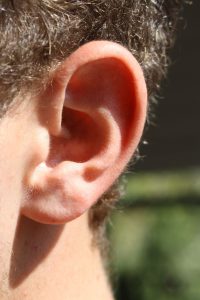3.4 The Listening Process
Listening is the learned process of receiving, interpreting, recalling, evaluating, and responding to verbal and nonverbal messages. We begin to engage with the listening process long before we engage in any recognizable verbal or nonverbal communication. It is only after listening for months as infants that we begin to consciously practise our own forms of expression. In this section, we will learn more about each stage of the listening process, the main types of listening, and the main listening styles.
The Listening Process

Listening is a process, and as such, doesn’t have a defined start and finish. Like the communication process, listening has cognitive, behavioural, and relational elements and doesn’t unfold in a linear, step-by-step fashion. The stages of the listening process are receiving, interpreting, recalling, evaluating, and responding.
The video below is an introduction to the topic of listening and to much of the content that will be discussed in this section.
(Study Hall, 2022)
Receiving
Before we can engage other steps in the listening process, we must take in stimuli through our senses. In any given communication encounter, it is likely that we will return to the receiving stage, sometimes referred to as attending, many times as we process incoming feedback and new messages. This part of the listening process is more physiological than other parts, which include cognitive and relational elements. We primarily take in information needed for listening through auditory and visual channels. Although we don’t often think about visual cues as a part of listening, they influence how we interpret messages. For example, seeing a person’s face when we hear their voice allows us to take in nonverbal cues from facial expressions and eye contact. The fact that these visual cues are missing in email, text, and phone interactions presents some difficulties for reading contextual clues into meaning received only through auditory channels.
The chapter on perception discusses some of the ways in which incoming stimuli are filtered. These perceptual filters also play a role in listening. Some stimuli never make it in, some are filtered into our subconscious, and others are filtered into various levels of consciousness based on their salience. Recall that salience is the degree to which something attracts our attention in a particular context and that we tend to find salience in things that are visually or audibly stimulating and that meet our needs or interests. Think about how it’s much easier to listen to a lecture on a subject that you find interesting.
It is important to consider noise as a factor that influences how we receive messages. Some noise interferes primarily with hearing, which is the physical process of receiving stimuli through internal and external components of the ears and eyes, and some interferes with listening, which is the cognitive process of processing the stimuli taken in during hearing. While hearing leads to listening, hearing and listening are not the same thing. Environmental noise, such as other people talking, the sounds of traffic, and music, interferes with the physiological aspects of hearing. Psychological noise, like stress and anger, interferes primarily with the cognitive processes of listening. We can enhance our ability to receive, and in turn listen, by trying to minimize noise.
Interpreting
During the interpreting stage, sometime referred to as understanding, we combine the visual and auditory information we receive and try to make meaning out of that information using schemata. The interpreting stage engages cognitive and relational processing as we take in informational, contextual, and relational cues and try to connect them to previous experiences in meaningful ways. It is through the interpreting stage that we begin to understand the stimuli we have received. When we understand something, we are able to attach meaning by connecting information to previous experiences. Through the process of comparing new information with old information, we may also update or revise particular schemata if we find the new information relevant and credible.
If we have difficulty interpreting information, meaning we don’t have previous experience or information in our existing schemata to make sense of it, then it is difficult to transfer the information into our long-term memory for later recall. In situations where understanding the information we receive isn’t important or isn’t a goal, this stage may be fairly short or even skipped. After all, we can move something to our long-term memory by repetition, and then later recall it without ever having understood it. It is possible to earn perfect scores on an exam in an anatomy class in college because you can memorize and recall, for example, all the organs in the digestive system. In fact, you might still be able to do that a decade after the exam. But you might not be able to tell the significance or function of most of those organs, meaning you didn’t really get to a level of understanding but simply stored the information for later recall.
Recalling
Our ability to recall information, or remember, is dependent on some of the physiological limits of how memory works. Overall, our memories are known to be fallible. We forget about half of what we hear immediately after hearing it, recall 35% after eight hours, and recall 20% after a day (Hargie, 2016). Our memory consists of multiple “storage units,” including sensory storage, short-term memory, working memory, and long-term memory (Hargie, 2016).
Our sensory storage is very large in terms of capacity but limited in terms of length of storage. We can hold large amounts of unsorted visual information but only for about a tenth of a second. By comparison, we can hold large amounts of unsorted auditory information for longer—up to four seconds. This initial memory storage unit doesn’t provide much use for our study of communication because these large but quickly expiring chunks of sensory data are primarily used in reactionary and instinctual ways.
As stimuli are organized and interpreted, they make their way to short-term memory, where they either expire and are forgotten or are transferred to long-term memory. Short-term memory is a mental storage capability that can retain stimuli for 20 seconds to one minute. Long-term memory is a mental storage capability to which stimuli in short-term memory can be transferred if they are connected to existing schema and in which information can be stored indefinitely (Hargie, 2016). Working memory is a temporarily accessed memory storage space that is activated during times of high cognitive demand. When using working memory, we can temporarily store information and process and use it at the same time. This is different from our typical memory function in that information usually has to make it to long-term memory before we can call it back to apply to a current situation. People with good working memories are able to keep recent information in mind, process it, and apply it to other incoming information. This can be very useful during high-stress situations.
Evaluating
When we evaluate something, we make judgements about its credibility, completeness, and worth. In terms of credibility, we try to determine the degree to which we believe a speaker’s statements are correct and/or true. In terms of completeness, we try to “read between the lines” and evaluate the message in relation to what we know about the topic or situation being discussed. We evaluate the worth of a message by making a value judgement about whether we think the message or idea is good or bad, right or wrong, or desirable or undesirable. All these aspects of evaluating require critical-thinking skills, which we aren’t born with but must develop over time through our own personal and intellectual development.
Studying communication is a great way to build your critical-thinking skills because you learn much more about the taken-for-granted aspects of how communication works, which gives you tools to analyze and critique messages, senders, and contexts. Critical-thinking and listening skills also help you take a more proactive role in the communication process rather than being a passive receiver of messages that may not be credible, complete, or worthwhile. One danger in the evaluation stage of listening is to focus your evaluative lenses more on the speaker than the message. This can quickly become a barrier to effective listening if we begin to prejudge a speaker based on their identity or characteristics rather than on the content of their message.
Responding
Responding entails sending verbal and nonverbal messages that indicate attentiveness and understanding or a lack thereof. From our earlier discussion of the communication model, you may be able to connect this part of the listening process to feedback.

We send verbal and nonverbal feedback while another person is talking and after they are finished. Back-channel cues are the verbal and nonverbal signals we send while someone is talking and can consist of verbal cues like “uh-huh,” “oh,” and “right,” or nonverbal cues like direct eye contact, head nods, and leaning forward. Back-channel cues are generally a form of positive feedback that indicates others are actively listening. People also send cues intentionally and unintentionally that indicate they aren’t listening. If another person is looking away, fidgeting, texting, or turned away, we will likely interpret those responses negatively.
The Importance of Listening
Understanding how listening works provides the foundation we need to explore why we listen, including the various types and styles of listening. In general, listening helps us achieve all the communication goals (physical, instrumental, relational, and identity) that we learned about in Chapter 1 and is also important in academic, professional, and personal contexts.

In terms of academics, poor listening skills were shown to contribute significantly to failure in a person’s first year of college (Zabava & Wolvin, 1993). In general, students with high scores for listening ability have greater academic achievement. Poor listening skills, lack of conciseness, and inability to give constructive feedback have been identified as potential communication challenges in professional contexts. Even though listening education is lacking in our society, research has shown that introductory communication courses provide important skills necessary for functioning in entry-level jobs, including listening, writing, motivating and persuading, interpersonal skills, informational interviewing, and small-group problem solving (Di Salvo, 1980). Listening also has implications for our personal lives and relationships. We shouldn’t underestimate the power of listening to make someone else feel better and to open our perceptual field to new sources of information.
The main purposes of listening are the following (Hargie, 2016):
- To focus on messages sent by other people or noises coming from our surroundings
- To better understand other people’s communication
- To critically evaluate other people’s messages
- To monitor nonverbal signals
- To indicate that we are interested or paying attention
- To empathize with others and show we care for them (relational maintenance)
- To engage in negotiation, dialogue, or other exchanges that result in shared understanding of or agreement on an issue
Listening Types
Listening serves many purposes, and different situations require different types of listening. The type of listening we engage in affects our communication and how others respond to us. For example, when we listen to empathize with others, our communication will likely be supportive and open, which will then allow the other person to feel “heard” and supported and hopefully view the interaction positively (Bodie & Villaume, 2003). The main types of listening we will discuss are discriminative, informational, critical, and empathetic (Watson et al., 1995).
Discriminative listening is a focused type of listening that is primarily physiological and occurs mostly at the receiving stage of the listening process. Here we engage in listening to scan and monitor our surroundings in order to isolate particular auditory or visual stimuli. For example, we may focus our listening on a dark part of the yard while walking the dog at night to determine whether the noise we just heard presents any danger. Or we may look for a particular nonverbal cue to let us know our conversational partner received our message (Hargie, 2016).
Informational listening entails listening with the goal of comprehending and retaining information. This type of listening is not evaluative and is common in teaching and learning contexts ranging from a student listening to an informative speech to an out-of-towner listening to directions to the nearest gas station. We also use informational listening when we listen to news reports, voicemail, and briefings at work.
Critical listening entails listening with the goal of analyzing or evaluating a message based on information presented verbally and information that can be inferred from context. A critical listener evaluates a message and accepts it, rejects it, or decides to withhold judgement and seek more information. As constant consumers of messages, we need to be able to assess the credibility of speakers and their messages and identify various persuasive appeals and faulty logic (known as fallacies).

Empathetic listening is the most challenging form of listening and occurs when we try to understand or experience what a speaker is thinking or feeling. Empathetic listening is distinct from sympathetic listening. Sympathy is generally more self-oriented and distant than empathy (Bruneau, 1993). Empathetic listening is oriented on others and should be genuine. Because of our own centrality in our perceptual world, empathetic listening can be difficult. It’s often much easier to tell our own story or to give advice than it is to really listen to and empathize with someone else. We should keep in mind that sometimes others just need to be heard and our feedback isn’t actually desired.
Listening Styles
Just as there are different types of listening, there are also different styles of listening. People may be categorized as one or more of the following types listeners: people-oriented, action-oriented, content-oriented, and time-oriented listeners. Research finds that 40% of people have more than one preferred listening style, and that they choose a style based on the listening situation (Bodie & Villaume, 2003). Other research finds that people often still revert back to a single preferred style in times of emotional or cognitive stress, even if they know a different style of listening would be better (Worthington, 2003).
- People-oriented listeners are concerned about the needs and feelings of others and may get distracted from a specific task or the content of a message in order to address feelings.
- Action-oriented listeners prefer well-organized, precise, and accurate information. They can become frustrated if they perceive communication to be unorganized or inconsistent, or a speaker to be “long-winded.”
- Content-oriented listeners are analytic and enjoy processing complex messages. They like in-depth information and like to learn about multiple sides of a topic or hear multiple perspectives on an issue. Their thoroughness can be difficult to manage if there are time constraints.
- Time-oriented listeners are concerned with completing tasks and achieving goals. They do not like information they perceive as irrelevant and like to stick to a timeline. They may cut people off and make quick decisions (taking shortcuts or cutting corners) when they think they have enough information.
Types of Listening Responses
Silent listening occurs when a person says nothing. It is ideal in certain situations and awful in others. However, when used correctly, silent listening can be very powerful. If misused, the listener could give the wrong impression to someone. It is appropriate to use this type of listening to discourage more talking. It also shows that the listener is open to the speaker’s ideas (Wrench et al., 2020).

Sometimes people get angry when someone doesn’t respond. They might think that this person is not listening or is trying to avoid the situation (Wrench et al., 2020). But the lack of response might be because the listener is just trying to gather their thoughts or perhaps feels that it would be inappropriate to respond. There are certain situations, such as in counselling, where silent listening can be beneficial because it can help the speaker figure out their feelings and emotions. Minor prompting might also be done in combination with silence (Wrench et al., 2020).
In situations where you want to get answers, it might be beneficial to use questioning. You can do this in a variety of ways (Wrench et al., 2020). You can pose open-ended or close-ended questions as a means of eliciting answers. Close-ended questions are very specific and do not allow elaboration. They are direct and often result in a “yes” or “no” response or a list of possible responses that are provided. Open-ended questions allow for more elaboration by the person responding, and specific response options are not provided. These forms of questions generally result in more discussion.
There are also different types of questions. Sincere questions are posed to find a genuine answer (Wrench et al., 2020). Counterfeit questions are disguised attempts to send a message, not to receive one. Sometimes, counterfeit questions can cause the listener to be defensive. For instance, if someone asks you, “Tell me how often you have cheated on an exam,” the speaker is implying that you have cheated on an exam, even though that has not been established (Wrench et al., 2020). A speaker can use questions that make statements by emphasizing specific words or phrases, stating an opinion or feeling on the subject. They can ask questions that carry hidden agendas, such as “Do you have five dollars?” because the person would like to borrow that money (Wrench et al., 2020). Some questions seek “correct” answers. For instance, when a friend asks, “Do I look fat?” you probably have a correct or ideal answer. There are also questions that are based on unchecked assumptions. An example would be “Why aren’t you listening?” This question implies that the person wasn’t listening, when in fact they are listening (Wrench et al., 2020).
Paraphrasing is defined as restating in your own words the message you think the speaker just sent (Wrench et al., 2020). It represents mindful listening in that you are trying to analyze and understand the speaker’s information. Paraphrasing can be used to summarize facts and to gain consensus in essential discussions. It could be used in a business meeting to make sure all details were discussed and agreed upon. Paraphrasing can also be used to understand personal information more accurately. Think about being in a counsellor’s office. Counsellors often paraphrase information to better understand exactly how you are feeling and to be able to analyze the information better (Wrench et al., 2020).
Empathizing is used to show that the listener identifies with the speaker’s information (Wrench et al., 2020). However, you are not empathizing when you deny others the rights to their feelings. Examples of this are statements such as “It’s really not a big deal” or “Who cares?” These response indicates that the listener is trying to make the speaker feel a different way. In minimizing the significance of the situation, the listener is interpreting the situation according to their perspective and passing judgement (Wrench et al., 2020).

Take the time to watch William Ury’s Ted Talk on the power of listening. He talks about how important listening is and what a difference it can make to others and to society as a whole.
(TEDx Talks, 2012)
Barriers to Effective Listening
Barriers to effective listening are present at every stage of the listening process (Hargie, 2016). At the receiving stage, noise can block or distort incoming stimuli. At the interpreting stage, complex or abstract information may be difficult to relate to previous experiences, making it difficult to reach understanding. At the recalling stage, natural limits to our memory and challenges to concentration can interfere with remembering. At the evaluating stage, personal biases and prejudices can lead us to block people out or assume we know what they are going to say. At the responding stage, a lack of paraphrasing and questioning skills can lead to misunderstanding.
Environmental and Physical Barriers to Listening
Environmental factors such as lighting, temperature, and furniture affect our ability to listen. A room that is too dark can make us sleepy, just as a room that is too warm or too cool can raise awareness of our physical discomfort to a point that it is distracting. Some seating arrangements facilitate listening, whereas others separate people. In general, listening is easier when listeners can make direct eye contact with and are in close physical proximity to the speaker. When group members are allowed to choose a leader, they often choose the person who is sitting at the centre or head of the table (Andersen, 1999). Even though the person may not have demonstrated any leadership abilities, people subconsciously gravitate towards speakers who are nonverbally accessible. The ability to effectively see and hear a person increases people’s confidence in their abilities to receive and process information. Eye contact and physical proximity can still be affected by noise. Environmental noises such as a whirring air conditioner, a barking dog, or a ringing fire alarm can obviously interfere with listening despite direct lines of sight and well-placed furniture.
Physiological noise, like environmental noise, can interfere with our ability to process incoming information. It is noise stemming from a physical illness, injury, or bodily stress. Physiological noise is considered a physical barrier to effective listening because it emanates from our physical body. Ailments such as a cold, a broken leg, a headache, or an itchy rash can range from annoying to unbearably painful and impact our listening relative to their intensity. Another type of noise, psychological noise, bridges physical and cognitive barriers to effective listening.
Psychological noise, or noise stemming from our psychological state, including moods and level of arousal, can facilitate or impede listening. Any mood or state of arousal, positive or negative, that is too far above or below our regular baseline creates a barrier to message reception and processing. The generally positive emotional state of being in love can be just as much of a barrier as feeling hatred. Excited arousal can also distract as much as anxious arousal. Stress about an upcoming event ranging from losing a job, to having surgery, to wondering about what to eat for lunch can overshadow incoming messages. Although we will explore cognitive barriers to effective listening more in the next section, psychological noise is relevant here given that the body and mind are not completely separate. In fact, they can interact in ways that further interfere with listening. Fatigue, for example, is usually a combination of psychological and physiological stresses that manifests as stress (psychological noise) and weakness, sleepiness, and tiredness (physiological noise). Additionally, mental anxiety (psychological noise) can also manifest itself in our bodies through trembling, sweating, blushing, or even breaking out in a rash (physiological noise).
Cognitive and Personal Barriers to Listening
Aside from the barriers to effective listening that may be present in the environment or from our bodies, cognitive limits, a lack of listening preparation, difficult or disorganized messages, and prejudices can interfere with listening. Whether you call it multitasking, daydreaming, glazing over, or drifting off, we all cognitively process other things while receiving messages. If you think of your listening mind as a wall of televisions, you may notice that in some situations some of the televisions are tuned to one channel. If that one channel is a lecture being given by your professor, then you are exerting about half of your cognitive-processing abilities on one message. In another situation, all the televisions may be on different channels. The fact that we have the capability to process more than one thing at a time offers both advantages and disadvantages, but unless we can better understand how our cognitive capacities and personal preferences affect our listening, we are likely to experience more barriers than benefits.
Lack of Listening Preparation
Another barrier to effective listening is a general lack of listening preparation. Unfortunately, most people have never received any formal training or instruction related to listening. Although some people think listening skills just develop over time, competent listening is difficult, and improving listening skills takes concerted effort. Even when listening education is available, people do not embrace it as readily as they do opportunities to enhance their speaking skills. Listening is often viewed as an annoyance or a chore, or else it is just ignored or minimized as part of the communication process. In addition, our individualistic society values speaking more than listening because it’s the speakers who are sometimes literally in the spotlight. Although listening competence is a crucial part of social interaction, and many of us value people we perceive to be “good listeners,” listening just doesn’t get the same kind of praise, attention, instruction, or credibility as speaking does.
Bad Messages and/or Speakers
Bad messages and/or speakers also present a barrier to effective listening. Sometimes our trouble listening originates in the sender. In terms of message construction, poorly structured messages or messages that are too vague, too jargon filled, or too simple can present listening difficulties. In terms of a speaker’s delivery, verbal fillers, a monotone voice, distracting movements, or a dishevelled appearance can inhibit our ability to cognitively process a message (Hargie, 2016). Speakers can employ particular strategies to create listenable messages that take some of the burden off the listener by tailoring a message to be easily heard and processed. Strategies for creating messages tailored for oral delivery include elements such as preview and review statements, transitions, and parallel wording. Listening also becomes difficult when a speaker tries to present too much information. Information overload is a common barrier to effective listening that good speakers can mitigate by building redundancy into their speeches and providing concrete examples of new information to help audience members interpret and understand the key ideas.
Prejudiced Listening
Unfortunately, some of our default ways of processing information and perceiving others lead us to rigid ways of thinking. When we engage in prejudiced listening, we are usually trying to preserve our way of thinking and avoid being convinced of something different. This type of prejudice is a barrier to effective listening because when we prejudge a person based on their identity or ideas, we usually stop listening in an active and/or ethical way.
We exhibit prejudice in our listening in several ways, some of which are more obvious than others. For example, we may claim to be in a hurry and only selectively address the parts of a message that we agree with or that aren’t controversial. We can also operate from a state of denial where we avoid a subject or person altogether so that our views are not challenged. Prejudices that are based on a person’s identity, such as race or ethnicity, age, occupation, or appearance, may lead us to assume that we know what the person will say, essentially closing down the listening process. Keeping an open mind and engaging in perception checking can help us identify prejudiced listening and hopefully shift into more competent listening practices.
Ineffective Listening Behaviours
At times, the barriers to effective listening cause us to engage in ineffective listening behaviours. When our goal is to create shared meaning with others, these behaviours interrupt this process.
- Pseudo-listening is pretending to listen and appear attentive but not listening to understand or interpret the information. Listeners may respond with a smile, head nod, or even a minimal verbal acknowledgment, but they are ignoring or not attending (Indiana State University, n.d.).
- Selective listening involves the listener selecting only the information they identify as relevant to their own needs or interests. Listeners may have their own agenda and disregard topics if they do not align with their current attitudes or beliefs (Indiana State University, n.d.).
- Insulated listening involves ignoring or avoiding information and certain topics of conversation. It can be seen as the opposite of selective listening.
- Defensive listening can be seen as interpreting innocent comments as personal attacks. Listeners misinterpret or project feelings of insecurity, jealousy, guilt, or lack of confidence in the other person (Indiana State University, n.d.).
- Insensitive listening involves focusing on information for its literal meaning and disregarding the other person’s feeling and emotions. Listeners rarely pick up on hidden meanings or subtle nonverbal cues and have difficulty expressing sympathy and empathy (Indiana State University, n.d.).
- Stage hogging involves listening to express one’s own ideas or interests and being the centre of attention. Listeners often plan what they are going to say or interrupt while the other person is talking (Indiana State University, n.d.).
- Ambushing is careful and attentive listening to collect information that can be used against the other person as an attack. Listeners question, contradict, or oppose the other person to trap them or use their own words against them (Indiana State University, n.d.).
- Multitasking involves listening without full attention while attempting to complete more than one task at a time. Listeners are actually “switch tasking”—their brain is rapidly switching from one task to another—and the information is lost (Indiana State University, n.d.).
In this section, we had a chance to discuss the many aspects of the listening process, and since this such a valuable skill, the next section will focus on the skills needed to becoming more competent listeners.
Relating Theory to Real Life
- Identify how critical listening might be useful for you in each of the following contexts: academic, professional, personal, and civic.
- Listening scholars have noted that empathetic listening is the most difficult type of listening. Do you agree? Why or why not?
- Which style of listening best describes you and why? Which style do you have the most difficulty with or like the least and why?
- Bad speakers and messages are a common barrier to effective listening. Describe a time recently when your ability to listen was impaired by the poor delivery and/or content of another person.
- Of the bad listening practices listed, which do you use the most? Why do you think you use this one more than the others? What can you do to help prevent or lessen this barrier?
Attribution
Unless otherwise indicated, material on this page has been copied and adapted from the following resource:
University of Minnesota. (2016). Communication in the real world: An introduction to communication studies. University of Minnesota Libraries Publishing. https://open.lib.umn.edu/communication, licensed under CC BY-NC-SA 4.0, except where otherwise noted.
References
Andersen, P. A. (1999). Nonverbal communication: Forms and functions. Mayfield.

